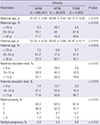1. Kim HS. Social integration and heath policy issues for international marriage migrant women in South Korea. Public Health Nurs. 2010; 27:561–570.
3. Iyasu S, Tomashek K, Barfield W. Infant mortality and low birth weight among black and white infants—United States, 1980–2000. JAMA. 2002; 288:825–826.
4. Migone A, Emanuel I, Mueller B, Daling J, Little RE. Gestational duration and birthweight in white, black and mixed-race babies. Paediatr Perinat Epidemiol. 1991; 5:378–391.
5. Polednak AP, King G. Birth weight of US biracial (black-white) infants: regional differences. Ethn Dis. 1998; 8:340–349.
6. Gold KJ, DeMonner SM, Lantz PM, Hayward RA. Prematurity and low birth weight as potential mediators of higher stillbirth risk in mixed black/white race couples. J Womens Health (Larchmt). 2010; 19:767–773.
7. Collins JW Jr, David RJ. The differential effect of traditional risk factors on infant birthweight among blacks and whites in Chicago. Am J Public Health. 1990; 80:679–681.
9. Troe EJ, Raat H, Jaddoe VW, Hofman A, Looman CW, Moll HA, Steegers EA, Verhulst FC, Witteman JC, Mackenbach JP. Explaining differences in birthweight between ethnic populations. The Generation R Study. BJOG. 2007; 114:1557–1565.
10. Wells JC, Sharp G, Steer PJ, Leon DA. Paternal and maternal influences on differences in birth weight between Europeans and Indians born in the UK. PLoS One. 2013; 8:e61116.
11. Geronimus AT. Black/white differences in the relationship of maternal age to birthweight: a population-based test of the weathering hypothesis. Soc Sci Med. 1996; 42:589–597.
12. Beadle MR, Graham GN, Jarris PE, Hussein CA, Morgan A, Finch R. A national partnership for action to end health disparities in the United States. In : Proceedings of the World Conference on Social Determinants of Health; 19??1 October 2011; Rio de Janeiro, Brazil. Geneva: World Health Organization;2011.
13. Vintzileos AM, Ananth CV, Smulian JC, Scorza WE, Knuppel RA. Prenatal care and black-white fetal death disparity in the United States: heterogeneity by high-risk conditions. Obstet Gynecol. 2002; 99:483–489.
14. Kaufman JS, Cooper RS, McGee DL. Socioeconomic status and health in blacks and whites: the problem of residual confounding and the resiliency of race. Epidemiology. 1997; 8:621–628.
15. Srinivasjois RM, Shah S, Shah PS; Knowledge Synthesis Group on Determinants of Preterm/LBW Births. Biracial couples and adverse birth outcomes: a systematic review and meta-analyses. Acta Obstet Gynecol Scand. 2012; 91:1134–1146.
16. Park MJ, Son M, Kim YJ, Paek D. Social inequality in birth outcomes in Korea, 1995–2008. J Korean Med Sci. 2013; 28:25–35.
17. National Center for Health Statistics. Advance report of final mortality statistics, 1989. Mon Vital Stat Rep. 1992; 40:1–52.
18. National Center for Health Statistics. Annual summary of births, marriages, divorces, and deaths: United States, 1994. Mon Vital Stat Rep. 1995; 43:1–44.
19. American Congress of Obstetricians and Gynecologists. Fetal Macrosomia. ACOG Technical Bulletin No. 159. Washington, D.C.: American Congress of Obstetricians and Gynecologists;1991.
20. Spellacy WN, Miller S, Winegar A, Peterson PQ. Macrosomia--maternal characteristics and infant complications. Obstet Gynecol. 1985; 66:158–161.
21. Parks DG, Ziel HK. Macrosomia. A proposed indication for primary cesarean section. Obstet Gynecol. 1978; 52:407–409.
22. Bérard J, Dufour P, Vinatier D, Subtil D, Vanderstichèle S, Monnier JC, Puech F. Fetal macrosomia: risk factors and outcome. A study of the outcome concerning 100 cases >4500 g. Eur J Obstet Gynecol Reprod Biol. 1998; 77:51–59.
23. Kim MJ. A comparative study on birth outcomes between Korean women and immigrant women. Korean J Women Health Nurs. 2011; 17:407–414.
24. Tsai YR, Lan KC, Kung FT, Lin PY, Chiang HJ, Lin YJ, Huang FJ. The effect of advanced paternal age on the outcomes of assisted reproductive techniques among patients with azoospermia using cryopreserved testicular spermatozoa. Taiwan J Obstet Gynecol. 2013; 52:351–355.
25. Dain L, Auslander R, Dirnfeld M. The effect of paternal age on assisted reproduction outcome. Fertil Steril. 2011; 95:1–8.
26. Astolfi P, De Pasquale A, Zonta LA. Paternal age and preterm birth in Italy, 1990 to 1998. Epidemiology. 2006; 17:218–221.









 PDF
PDF ePub
ePub Citation
Citation Print
Print




 XML Download
XML Download